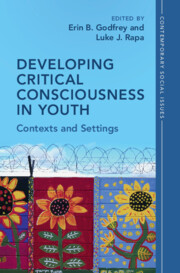Book contents
- Developing Critical Consciousness in Youth
- Contemporary Social Issues Series
- Developing Critical Consciousness in Youth
- Copyright page
- Dedication
- Contents
- Figures
- Tables
- Contributors
- Acknowledgments
- Introduction
- Part I Pedagogical, Curricular, and School-Based Contexts
- Part II Extracurricular Contexts
- Part III Societal Contexts
- 7 Critical Race Consciousness
- 8 The Quest for Racial Justice
- 9 Critical Consciousness Development among Undocumented Youth
- 10 Influences of Sense of Social Responsibility, Immigrant Bargain, and Immigrant Optimism on Critical Consciousness Development among Immigrant Youth of Color
- Concluding Thoughts on the Role of Contexts and Settings in Youth Critical Consciousness Development
- Index
- References
8 - The Quest for Racial Justice
An Overview of Research on Racism and Critical Action for Youth of Color
from Part III - Societal Contexts
Published online by Cambridge University Press: 11 May 2023
- Developing Critical Consciousness in Youth
- Contemporary Social Issues Series
- Developing Critical Consciousness in Youth
- Copyright page
- Dedication
- Contents
- Figures
- Tables
- Contributors
- Acknowledgments
- Introduction
- Part I Pedagogical, Curricular, and School-Based Contexts
- Part II Extracurricular Contexts
- Part III Societal Contexts
- 7 Critical Race Consciousness
- 8 The Quest for Racial Justice
- 9 Critical Consciousness Development among Undocumented Youth
- 10 Influences of Sense of Social Responsibility, Immigrant Bargain, and Immigrant Optimism on Critical Consciousness Development among Immigrant Youth of Color
- Concluding Thoughts on the Role of Contexts and Settings in Youth Critical Consciousness Development
- Index
- References
Summary
Critical action – action to dismantle oppression and seek justice – is often motivated by and in response to being subjected to racism. Indeed, critical action can be an adaptive coping response to racism, such that critical action might reduce the negative impacts of racism on the individual. Further, the goal of critical action, at its core, is to eliminate racism and its coconspiring forms of oppression, eradicating the root source of harm to marginalized individuals and communities. In this chapter, we provide an overview of current research that has examined how racism is related to critical action for racially marginalized youth. We consider racism as a system of oppression that manifests through culture, institutions, and individuals, along with stress responses to racism. We then provide recommendations for future research and practice to extend our understanding of if, when, and how experiencing racism motivates or detracts from youth critical action.
- Type
- Chapter
- Information
- Developing Critical Consciousness in YouthContexts and Settings, pp. 232 - 265Publisher: Cambridge University PressPrint publication year: 2023



